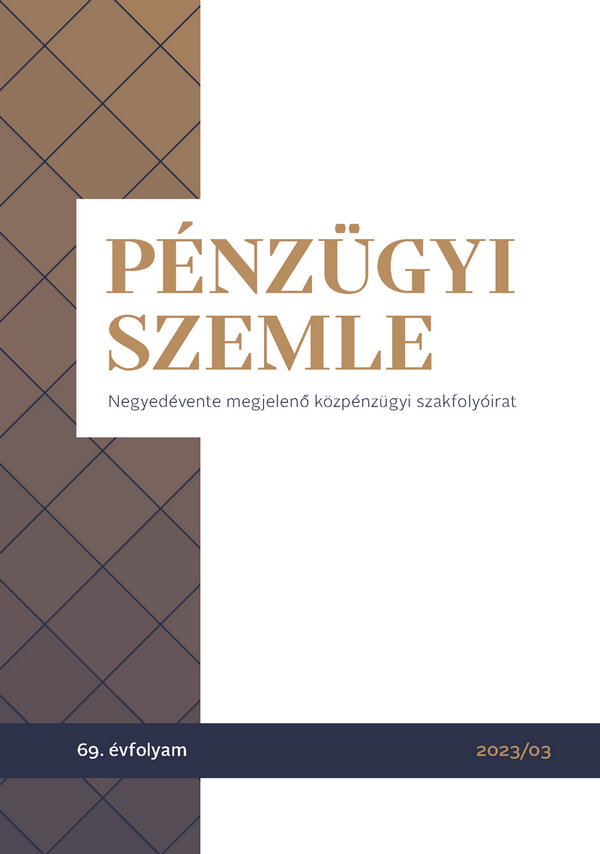Handling outliers in bankruptcy prediction models based on logistic regression
DOI:
https://doi.org/10.35551/PFQ_2023_3_5Keywords:
bankruptcy prediction, default risk, logistic regression, outlier management, G33, C6, G17Abstract
The primary tool for managing bank default risk is the credit rating of potential customers. The focus of the present study is on the logistic regression method used to construct 95% of the lender scorecards. The aim of the research is to determine how much the treatment of outliers improves the classification accuracy of the models when using a method that is highly sensitive to outliers, and which method of treating outliers results in the highest classification accuracy. Furthermore, what criteria should be used to determine the cut-off value of the models for a sample that does not contain solvent and insolvent businesses in equal proportions. The analysis was carried out on a sample of 1677 construction companies. The results show that the treatment of outliers significantly improves the predictive ability of the models, while the replacement of outliers with the closest non-outlier proved to be the most effective for treating outliers. When determining the cut-off, it is inappropriate to use the value that results in the highest classification accuracy, as this may lead to an increase in the proportion of first-order errors. The optimisation of this value may depend on the degree of credit risk taken by a given financial institution in its portfolio of loans.
References
Bellovary, J. L., Giacomino, D. E., Akers, M. D. (2007). A Review of Bankruptcy Prediction Studies: 1930 to Present, Journal of Financial Education, Vol. 33, pp. 1-42.
Cziglerné Erb E. (2020). A reziduálisjövedelem-modell újbóli megjelenése a vállalatok és a beruházási projektek értékelésében, Pénzügyi Szemle, 3, pp. 430-442.
Doma, T., Kozma, N. (2022). A Covid 19-járvány hatása a magyarországi bankok működési kockázati veszteségeire, Gazdaság és Pénzügy, 9, pp 356-375. https://doi.org/10.33926/GP.2022.4.3
du Jardin, P. (2010). Predicting bankruptcy using neural networks and other classification methods: The influence of variable selection techniques on model accuracy, Neurocomputing, 73, pp. 2047-2060. https://doi.org/10.1016/j.neucom.2009.11.034
Kiss G., Kosztopulosz A., Szládek D. (2021). A magánkiadások hatása a hazai egészségügyi diagnosztikai szolgáltatók pénzügyi helyzetére, Köz-Gazdaság, 16, pp. 115-132. https://doi.org/10.14267/retp2021.04.08
Kristóf, T. (2005). A csődelőrejelzés sokváltozós statisztikai módszerei és empirikus vizsgálata, Statisztikai Szemle, 9, pp. 841-863.
Kristóf, T., Virág, M. (2019). A csődelőrejelzés fejlődéstörténete Magyarországon, Vezetéstudomány, 12, pp. 62-73.
KSH (2021). Helyzetkép, 2021 – Építőipar, Központi Statisztikai Hivatal, Budapest
Limpek, Á., Kosztopulosz, A., Balogh P. (2016). Késedelmes fizetés, tartozási láncok-A Dél-Alföld régió kis-és középvállalkozásainak pénzügyi kultúrája, Statisztikai Szemle, 94, pp. 365-387. https://doi.org/10.20311/stat2016.04.hu0365
Mikolasek, A. (2018). A hitelkockázati modellek alkalmazásának néhány problémája, Gazdaság és Pénzügy, 3, pp. 248-257.
Nyitrai, T. (2015). Hazai vállalkozások csődjének előrejelzése egy, két, illetve három évvel korábbi pénzügyi beszámolók adatai alapján, Vezetéstudomány, 5, pp. 55-65. ohttps://doi.org/10.14267/veztud.2015.05.06
Nyitrai, T. (2017). Stock és flow típusú számviteli adatok alkalmazása a csődelőrejelző modellekben, Vezetéstudomány, 48, pp. 68-77. https://doi.org/10.14267/veztud.2017.09.07
Nyitrai, T., Virág M. (2017). A pénzügyi mutatók időbeli tendenciájának figyelembevétele logisztikus regresszióra épülő csődelőrejelző modellekben, Statisztikai Szemle,1, pp. 5-28. https://doi.org/10.20311/stat2017.01.hu0005
Pálinkó, É., Svoób Á. (2016). A vállalati csőd bekövetkezésének fő okai és a csődhöz vezető folyamat, Pénzügyi Szemle, 4, pp. 528-543.
Piller, Zs., (2013). A fizetésképtelenségi eljárások illeszkedési módjai nemzetközi összehasonlításban, Pénzügyi Szemle, 2, pp. 151-164.
Rácz, T. A., Tóth, B. (2021). A hazai önkormányzatok pénzügyi zavarai az adósságkonszolidáció és az önkormányzati rendszer reorganizációjának tükrében, Pénzügyi Szemle, 1, pp. 88-108. https://doi.org/10.35551/psz_2021_1_5
Virág M, (2004). A csődmodellek jellegzetességei és története, Vezetéstudomány, 10, pp. 24-32.
Virág, M., Kristóf T. (2006). Iparági rátákon alapuló csődelőrejelzés sokváltozós statisztikai módszerekkel, Vezetéstudomány, 37, pp. 25-35. https://doi.org/10.14267/veztud.2006.01.04
Virág, M., Kristóf, T. (2009). Többdimenziós skálázás a csődmodellezésben, Vezetéstudomány, pp. 50-29. https://doi.org/10.14267/veztud.2009.01.05
Vörösmarty, Gy., Dobos, I. (2020). A vállalatméret hatása a zöldbeszerzési gyakorlatra, Statisztikai Szemle, 4, pp. 301-323. https://doi.org/10.20311/stat2020.4.hu0301
Zavgren, C. V. (1985). Assessing the vulnerability to failure of Americn industrial firms: a logistic analysis, Journal of Business Finance & Accounting, 12(1), pp. 19-45.
Zéman, Z., Hegedűs, Sz., Molnár, P. (2018). Az önkormányzati vállalkozások hitelképességének vizsgálata credit scoring módszerrel, Pénzügyi Szemle, 2, pp. 182-200.
Zmijewski, M. E. (1984). Methodological Issues Related tot he Estimation of Financial Distress Predection Models, Journal of Accounting Research, Vol. 22, pp. 59-82.
Downloads
Published
How to Cite
Issue
Section
License
Authors assign copyright to Pénzügyi Szemle / Public Finance Quarterly. Authors are responsible for permission to reproduce copyright material from other sources.












